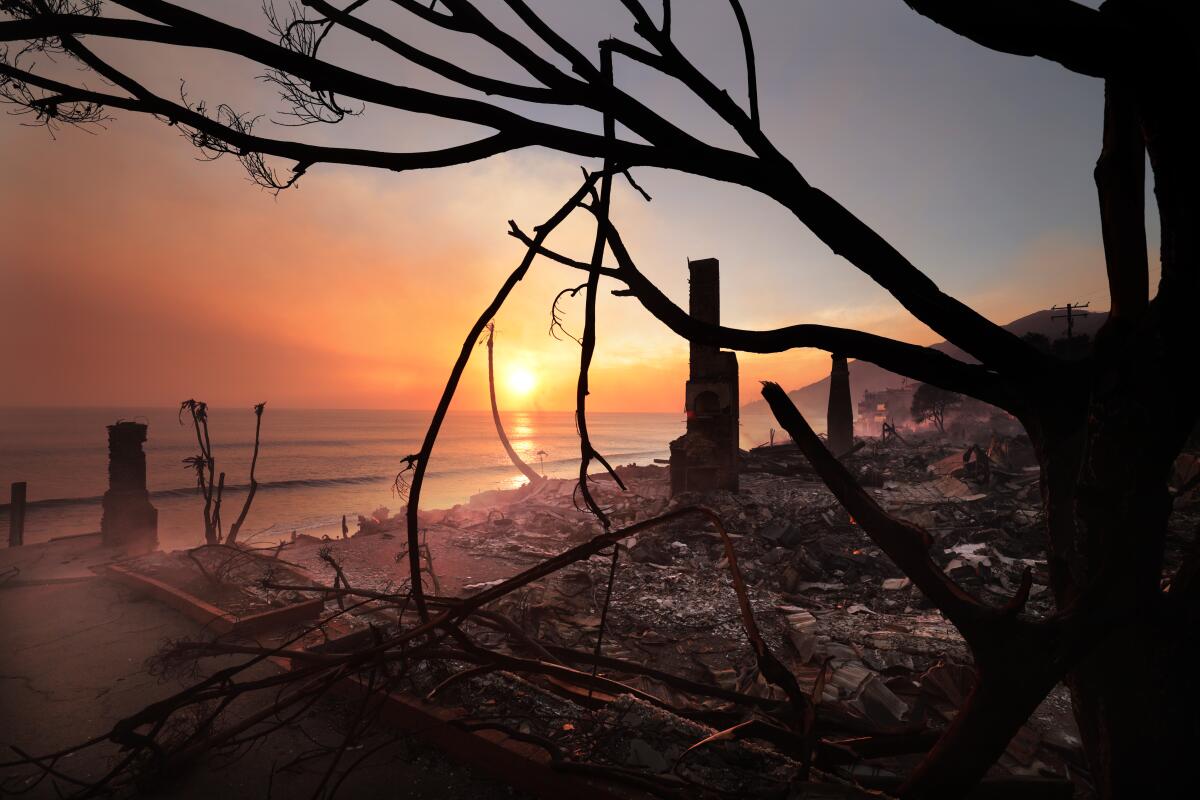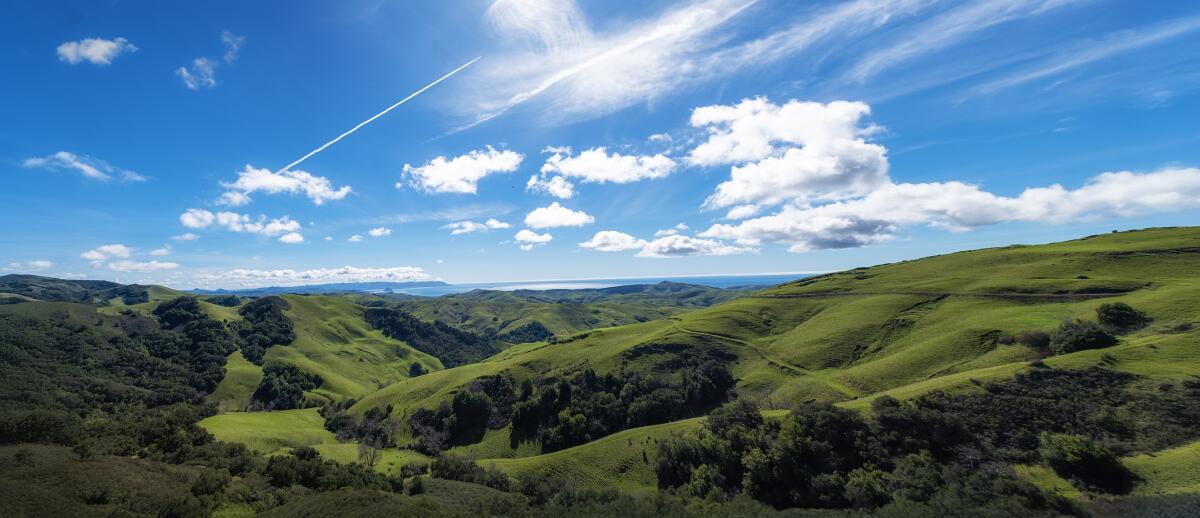What (or who) sparked L.A. County wildfires? Here’s where investigations stand

Good morning. Here’s what you need to know to start your day.
- Where investigations stand in finding the origins of L.A. County’s fires.
- Amid fires, hotels from O.C. to Palm Springs see a rush of Angelenos.
- An Arts District hub redefines the bistro for Los Angeles.
- And here’s today’s e-newspaper.
You're reading Essential California
Sign up to get the most important California stories and recommendations in your inbox every morning.
You may occasionally receive promotional content from the Los Angeles Times.
Finding the fateful sparks
It’s mind-boggling to think that the deadly, raging infernos that consumed communities in greater Los Angeles and will leave lasting scars on the region began perhaps as minuscule sparks.
All the destruction and loss were part of chain reactions that fire investigators are now trying to trace back to their incandescent origins.
As of Monday night, the Palisades fire had burned over 23,700 acres and was 14% contained. The Eaton fire grew past 14,000 acres and was 33% contained.
As those major and other smaller fires continue to scorch L.A. County, local, state and federal investigators are working to determine exactly where and how each blaze began. Here’s what we know so far about the efforts.

The investigations could take months (or more)
It will likely take considerable time before an official cause is reported for each fire.
“Experts said the cause of wildfires, including those that sweep into urban areas, can be extremely difficult to investigate — for obvious reasons, including the intensity and temperature of such large blazes destroying nearly everything in their path,” my colleagues Kevin Rector and Ian James explained over the weekend.
Widespread fires that begin during extreme weather events can sometimes have multiple origin points, an expert told them.
In the meantime, Times reporters spoke with residents who witnessed the blazes’ opening moments.

Over in Pacific Palisades, residents point to the area around Temescal Ridge trail, which features rock formations and stunning ocean views. Just a week before the Palisades fire broke out, a small brush fire started on New Year’s Eve and was knocked down in the same general area. Fire officials believe that blaze was sparked by holiday fireworks.
One resident told Times reporters he’d smelled smoke near the previous fire’s burn scar while hiking the trail shortly before the Palisades fire was reported. He wondered if some still-smoldering embers from that Dec. 31 fire had been kicked up by the powerful winds that pummeled the area Jan. 7.
An official from the U.S. Bureau of Alcohol, Tobacco, Firearms and Explosives, which is leading the Palisades fire investigation, said nothing is conclusive this early on.
However, there is historical precedent for an old fire sparking a new one, as Times reporters Richard Winton, Noah Goldberg and Hannah Fry noted in their coverage.
“The massive Oakland Hills fire of 1991 — which destroyed more than 2,500 structures — exploded after firefighters thought they had contained it,” they wrote. “That fire was originally six acres and was declared contained, but not out. Firefighters left equipment at the scene but did not monitor it at all times. Winds picked up and then flames quickly consumed homes.”

Southern California Edison power equipment becomes a focal point
Across the L.A Basin, investigators are focused on an area of Eaton Canyon where an electrical tower looms over Altadena.
Photos and videos from residents shared by news organizations and on social media showed what appeared to be the initial flames of the Eaton fire.
Altadena resident Marcus Errico told Times reporters he clearly saw “a small ring of flames around the base of one of the [electrical] towers.”
Those towers are the property of Southern California Edison. On Sunday, the utility company said its transmission tower lines were energized around the time of the fire. In a report, they stated that an early analysis showed “no interruptions or electrical or operational anomalies until more than one hour after the reported start time of the fire.”

The California Department of Forestry and Fire Protection (Cal Fire) is leading the investigation into the Eaton fire and confirmed the area around the towers is being studied, though the full scope of their probe was not divulged to The Times.
But attorneys for homeowners in Altadena aren’t waiting for investigators to name a culprit. Four lawsuits were filed Monday, each blaming Southern California Edison for starting the Eaton fire.
Power companies are no stranger to such lawsuits. Last February, Edison agreed to pay the U.S. $80 million to cover costs and damages from 2017’s deadly Thomas fire. Investigators determined that Edison equipment started that blaze, which burned more than 280,000 acres in Ventura and Santa Barbara counties.
And back in 2019, Pacific Gas & Electric agreed to a $13.5-billion settlement for several deadly Northern California wildfires, including 2018’s Camp fire.

Smaller blazes sparked last week are also under investigation
The Kenneth fire, which scorched a little over 1,000 acres in the hills north of Calabasas, was fully contained over the weekend.
A 33-year-old man was arrested last week by LAPD officers after he was seen attempting to spark a fire in the same vicinity, according to a law enforcement email obtained by The Times. The man has so far not been charged with arson as investigators continue their work.
Edison equipment is also a focal point of the investigation into what started the Hurst fire that has burned about 800 acres near Sylmar and was 95% contained as of Monday evening.
The company reported last week that one of its conductors had been damaged at a tower in the vicinity of the fire, but it could not determine if the equipment downed before or after the blaze.
The cause of the Sunset fire is also under investigation. That blaze scorched an estimated 46 acres in the Hollywood Hills and prompted panicked evacuations, but was fully contained in about 24 hours and did not destroy any homes.
The origin almost always leads back to humans
Extreme weather and climate conditions may prime California’s tinderbox landscapes, but we’re overwhelmingly the ones striking the metaphorical (or actual) match that grows into a wildfire.
Cal Fire estimates that up to 95% of wildfires are caused by humans, including from carelessness, infrastructure failures and deliberate ignitions.
A 2022 study from UC Irvine found that human-ignited fires were more ferocious and damaging than blazes sparked by lightning strikes.
More stories on L.A. County’s fires

Parts of L.A. County prepare for another windy forecast
- Weather service issues its most severe fire warning for parts of L.A. area as winds pick up.
- Newsom proposes $2.5 billion for wildfire response as L.A. burns.
- With her city in flames, L.A. Mayor Karen Bass’ political future hangs in the balance.
- Fire victims can get aid from the feds. How to apply for FEMA and avoid potential scams.
From Orange County to Palm Springs, Angelenos rush to fill hotel vacancies
- Legions of displaced families and individuals are grabbing rooms in surrounding counties, especially along the coast and in the desert.
- Fire evacuees can find rooms at these hotels in L.A. and beyond.
Rams play their ‘home’ playoff game in Arizona
- The Rams defeat the Vikings behind a nine-sack effort, setting up a showdown with the Eagles.
- How the NFL and Rams worked together to relocate playoff game amid an L.A. tragedy.
What else is going on
- The Supreme Court denies the oil industry’s plea to block climate lawsuits filed by California and other blue states.
- County jails may be able to improve access to medical care and lower death rates behind bars through healthcare accreditation — but the process still leaves inmates frustrated by low standards of care.
- Magic Johnson has won in NBA, MLB, WNBA and MLS as owner. His winning touch is showing in NFL.
- Trump flies U.S. flag at full height before end of 30-day mourning period for Carter.
Get unlimited access to the Los Angeles Times. Subscribe here.
Commentary and opinions
- Beautiful Altadena’s one-of-a-kind town was destroyed. But we can rebuild, guest columnist Sonali Kolhatkar writes.
- After the surgeon general’s warning on alcohol, people of faith should rethink sacramental wine, writes guest columnist Eli Federman.
- In the Trump-Musk post-truth world, conspiracies are traveling faster than the flames when it comes to the L.A. fires, columnist Anita Chabria writes.
This morning’s must reads

L.A.-area residents out of town during fires share agony of watching homes burn from afar. In interviews with several residents whose homes were destroyed while they were in places as far-flung as Europe, Asia and New York, they shared similar feelings: a sense of helplessness in the face of nature’s wrath.
How can we make this newsletter more useful? Send comments to [email protected].
For your downtime

Going out
- 🥘Downtown L.A.’s Camélia, a bistro serving French dishes inflected with Japanese flavors, comes to life from the couple behind Tsubaki.
Staying in
- 🍲What (and how) do you cook during an epic disaster?
- 🍝 Here’s a recipe for one-pan pasta with tomato sauce.
- ✏️ Get our free daily crossword puzzle, sudoku, word search and arcade games.
And finally ... your photo of the day
Show us your favorite place in California! Send us photos you have taken of spots in California that are special — natural or human-made — and tell us why they’re important to you.

Today’s great photo is from David Rosen of California: Highway 46 between Cambria and Templeton.
David writes: “I’m not sure if a highway can be considered a landmark, but if so, Highway 46 is a quintessential example of the beauty of California’s Central Coast. This photo was taken after a rainy winter season, making the views spectacular. Morro Bay can be seen in the distance.”
Have a great day, from the Essential California team
Ryan Fonseca, reporter
Defne Karabatur, fellow
Andrew Campa, Sunday reporter
Kevinisha Walker, multiplatform editor
Hunter Clauss, multiplatform editor
Christian Orozco, assistant editor
Stephanie Chavez, deputy metro editor
Karim Doumar, head of newsletters
Check our top stories, topics and the latest articles on latimes.com.
Sign up for Essential California
The most important California stories and recommendations in your inbox every morning.
You may occasionally receive promotional content from the Los Angeles Times.




